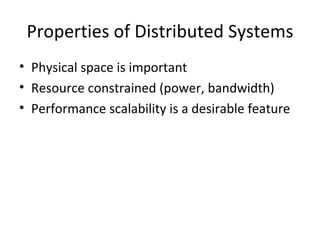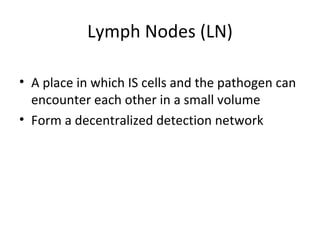Immune System Inspired Strategies for Distributed Systems
- 1. Modular RADAR: Immune System Inspired Strategies for Distributed Systems Soumya Banerjee and Melanie Moses
- 2. Distributed Systems Distributed sensors Environmental monitoring Disaster relief Military operations Multi-robot control Wireless sensor networks Intrusion detection systems Peer-to-peer systems
- 3. Properties of Distributed Systems Physical space is important Resource constrained (power, bandwidth) Performance scalability is a desirable feature
- 4. Natural Immune System Operates under constraints of physical space Resource constrained (metabolic input, number of immune system cells) Performance scalability is an important concern (mice to horses)(Banerjee and Moses, 2010, in review)
- 5. Problems Faced by the Immune System (IS) Only a few IS cells can respond to a pathogen
- 6. Search Problem They have to search throughout the whole body to locate small quantities of pathogens
- 7. Response Problem Have to respond by producing antibodies
- 8. Nearly Scale-Invariant Search and Response How does the immune system search and respond in almost the same time irrespective of the size of the search space?
- 9. Solution? Crivellato et al. 2004
- 10. Lymph Nodes (LN) A place in which IS cells and the pathogen can encounter each other in a small volume Form a decentralized detection network
- 11. Decentralized Detection Network www.lymphadvice.com
- 12. Modular RADAR Search is now modular efficient parallel We call this a modular RADAR ( R obust A daptive D ecentralized search A utomated R esponse)
- 20. Scaling of LN Size and Number this is in qualitative agreement with data need more data Banerjee and Moses 2010
- 21. Summary There are increasing costs to global communication as organisms grow bigger Semi-modular architecture balances the opposing goals of detecting pathogen (local communication) and recruiting IS cells (global communication) Can we emulate this modular RADAR strategy in distributed systems?
- 22. Peer-to-Peer Systems Used to provide distributed services like search, content integration and administration Computer nodes store data or service No single node has complete global information Decentralized search using local information to locate data
- 23. Semantic Small World (SSW) P2P Overlay Network Represents objects by a collection of attribute values derived from object content Aggregates data objects with similar semantics close to each other in clusters in order to facilitate efficient search It maintains short and long-distance connections between clusters. The long-distance connections follow a precise probability distribution making the whole overlay network small-world (Kleinberg 2000) * M. Li et al. 2004
- 24. Semantic Small World (SSW) P2P Overlay Network adapted from M. Li et al. 2004
- 25. Bounds for Efficient Decentralized Search in SSW Average search path length for search across clusters is where n is the total number of nodes, c is the number of nodes in a cluster, l is the number of long-distance connections per node M. Li et al. 2004
- 26. SSW with Modular RADAR Our contribution is to vary the cluster size vary the number of long-distance connections as such densification is seen as an emergent property of technological networks (Kleinberg 2004) and also incorporates redundant paths
- 27. Time to Search in SSW with Modular RADAR minimizing by differentiating with respect to c we have
- 29. Other Application Areas Similar tradeoffs could exist in Intrusion Detection Systems Multi-Robot Control Wireless Sensor Networks
- 30. Summary The immune system (IS) and distributed systems operate under similar constraints The IS has evolved a sub-modular RADAR architecture to arbitrate between local and global communication between distributed detectors Similar tradeoffs also exist in distributed systems Such a modular RADAR approach is shown to improve search times and robustness in a P2P system Can be applied in other distributed systems
- 31. Acknowledgements Dr. Melanie Moses Dr. Alan Perelson Dr. Stephanie Forrest Dr. Jedidiah Crandall Dr. Rob Miller Dr. Sam Loker SFI Complex Systems Summer School Travel grants from PIBBS (Dept. of Biology, UNM) Travel grants from RPT and SCAP (UNM) NIH COBRE CETI grant (RR018754)
Editor's Notes
- #6: only a few IS cells can respond
- #7: only a few IS cells can respond
- #8: only a few IS cells can respond
- #9: only a few IS cells can respond
- #10: DR
- #13: lymh n/w XX
- #14: one diramragm size of LN prop size of DR
- #15: one diramragm size of LN prop size of DR
- #16: one diramragm size of LN prop size of DR
- #17: one diramragm size of LN prop size of DR
- #22: redo
































